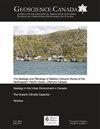Critical Minerals in the Context of Canada: Concepts, Challenges and Contradictions
IF 0.8
4区 地球科学
Q3 GEOSCIENCES, MULTIDISCIPLINARY
引用次数: 0
Abstract
Increased use of renewable energy, coupled with electrification of the economy, is considered important in efforts to limit future climate change. This energy transition is predicted to increase demands for some commodities, many of which are now labelled as critical mineral. The quest for such commodities is now a persistent theme for the resource industry and emerging government policies. This review for non-specialists explains several key concepts but also explores some challenges and apparent contradictions in the context of Canada. Canada now has a list of 31 critical minerals, but this includes some major commodities for which domestic production is significant and supply risk is low. The differences between our list and those of other jurisdictions reflect our more specific definitions. Most other commodities on Canada’s list are also identified by other countries and some are specifically linked to the energy transition. These include cobalt, lithium, manganese, nickel, graphite and vanadium (used in electric vehicle batteries and static energy storage), rare earth elements (REE; used for magnets in EV motors and wind turbines) and some rarer elements (e.g. germanium, gallium, indium and tellurium) used in photovoltaic (solar) energy systems. Some of these are potential primary products (e.g. lithium, graphite and REE) but many others (e.g. cobalt, platinum group elements and the photovoltaic elements) are byproducts from the production of major commodities, notably nickel, copper and zinc. The REE represent coproducts that are closely associated in nature and very hard to separate from each other; they are produced as a group. There are some specific challenges in exploring for and developing critical mineral resources. The end-use technology driving demand evolves on a timescale of years, but mineral exploration and development now typically take multiple decades. Material substitutions and unpredictable developments in technology complicate the exact prediction of future demands. The forecasts of overall relative demand growth are impressive, but for some key commodities global production will remain small in absolute terms, which may limit the potential for new discoveries. Simple measures of grade and tonnage are not always guarantees of viability, because deposits of some commodities (e.g. the REE) are mineralogically complex. Byproduct commodities cannot be produced in isolation, and many of these are only extracted in smelting and refining. Domestic production of these commodities is effectively lost if concentrates are exported for processing. The emissions and environmental impacts associated with production of critical mineral resources will also become important if such activity is to be linked to wider climate goals. This may present challenges in northern Canada, where renewable or low-carbon energy options are limited. Most draft Land Use Plans in the north presently emphasize large-scale land conservation, which could limit future exploration access before resource potential is fully assessed. Given the strong divisions of opinion about resource development, especially in the north, controversy and polarized debate will not easily be avoided. There are no simple answers to challenges that are political or jurisdictional rather than technical, but there is definitely a need for more public geoscientific information. This will help to identify areas of greatest potential, evaluate known deposits and contribute to future sustainable development. For many of the commodities on our critical mineral resources list, data for Canada remains incomplete, especially in more remote regions that are generally considered to have the highest potential.加拿大背景下的关键矿产:概念、挑战和矛盾
增加可再生能源的使用,加上经济电气化,被认为是限制未来气候变化的重要努力。预计这种能源转型将增加对某些大宗商品的需求,其中许多商品现在被列为关键矿产。如今,对这类大宗商品的追求已成为资源行业和新兴政府政策的一个永恒主题。这篇针对非专业人士的综述解释了几个关键概念,但也探讨了加拿大背景下的一些挑战和明显的矛盾。加拿大目前列出了31种关键矿产,但其中包括一些国内产量很大、供应风险较低的主要商品。我们的名单与其他司法管辖区的名单之间的差异反映了我们更具体的定义。加拿大清单上的大多数其他商品也被其他国家确定,其中一些与能源转型特别相关。这些包括钴、锂、锰、镍、石墨和钒(用于电动汽车电池和静态储能)、稀土元素(REE;用于电动汽车电机和风力涡轮机的磁铁)和一些用于光伏(太阳能)能源系统的稀有元素(例如锗,镓,铟和碲)。其中一些是潜在的初级产品(例如锂、石墨和稀土),但许多其他产品(例如钴、铂族元素和光电元素)是主要商品生产的副产品,特别是镍、铜和锌。稀土元素表现为在性质上联系紧密且难以分离的副产物;它们是作为一个群体生产的。在勘探和开发关键矿产资源方面存在着一些具体的挑战。推动需求的最终用途技术的发展需要几年的时间,但矿产勘探和开发现在通常需要几十年的时间。材料替代和不可预测的技术发展使对未来需求的准确预测复杂化。对总体相对需求增长的预测令人印象深刻,但就某些关键大宗商品而言,全球产量的绝对值仍将很小,这可能会限制新发现的潜力。简单的品位和吨位测量并不总是保证生存能力,因为某些商品(如稀土)的矿床在矿物学上是复杂的。副产品商品不能单独生产,其中许多只能在冶炼和精炼中提取。如果精矿出口加工,这些商品的国内生产实际上就会丧失。如果这种活动要与更广泛的气候目标联系起来,与关键矿物资源生产有关的排放和环境影响也将变得重要。这可能会给加拿大北部带来挑战,那里的可再生能源或低碳能源选择有限。目前大多数北方土地利用规划草案强调大规模的土地保护,这可能限制在资源潜力得到充分评估之前的未来勘探。鉴于对资源开发的强烈意见分歧,特别是在北方,争议和两极化的辩论将不容易避免。对于政治或司法而非技术方面的挑战,没有简单的答案,但肯定需要更多的公开地球科学信息。这将有助于查明潜力最大的地区,评价已知的矿藏,并为今后的可持续发展作出贡献。对于我们关键矿产资源清单上的许多商品,加拿大的数据仍然不完整,特别是在通常被认为具有最大潜力的较偏远地区。
本文章由计算机程序翻译,如有差异,请以英文原文为准。
求助全文
约1分钟内获得全文
求助全文
来源期刊

Geoscience Canada
地学-地球科学综合
CiteScore
3.30
自引率
0.00%
发文量
9
审稿时长
>12 weeks
期刊介绍:
Established in 1974, Geoscience Canada is the main technical publication of the Geological Association of Canada (GAC). We are a quarterly journal that emphasizes diversity of material, and also the presentation of informative technical articles that can be understood not only by specialist research workers, but by non-specialists in other branches of the Earth Sciences. We aim to be a journal that you want to read, and which will leave you better informed, rather than more confused.
 求助内容:
求助内容: 应助结果提醒方式:
应助结果提醒方式:


